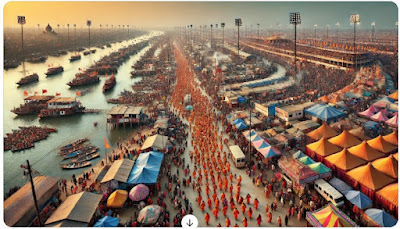Impact of Mahakumbh on Indian Economy
Here’s an
elaboration of the points related to the impact of the Mahakumbh on the Indian
economy and businesses benefiting from it:
1.
Introduction to the Mahakumbh Mela
The Mahakumbh Mela is one of the largest religious gatherings in the world,
held every 12 years at four locations in India: Prayagraj, Haridwar, Ujjain,
and Nashik. Millions of pilgrims, tourists, and spiritual seekers from across
the globe participate, making it a significant socio-cultural and economic
event.
2.
Economic Significance of the Mahakumbh
The Mahakumbh contributes significantly to the Indian economy by driving
tourism, boosting local businesses, and generating employment. The influx of
millions of visitors creates opportunities for revenue generation across
multiple sectors, from transportation to hospitality and retail.
3.
Sectors Benefiting from the Mahakumbh Mela
- Tourism and Hospitality
Industry
Hotels, guesthouses, dharamshalas, and homestays experience a surge in demand during the Mela. Tour operators, travel agencies, and tour guides also see increased business, with customized pilgrimage packages being offered to both domestic and international visitors. - Retail and Local Handicrafts
The Mahakumbh presents an opportunity for artisans and craftsmen to showcase their products, including religious artifacts, souvenirs, traditional clothing, and handmade crafts, leading to a boost in sales. - Transportation and Logistics
Increased footfall drives demand for railway, air, and road transportation. Auto-rickshaws, taxis, buses, and even boat services see a significant rise in revenue. Additionally, logistics companies benefit from the transport of goods and supplies required for the event. - Food and Beverage Sector
The demand for vegetarian and sattvic food skyrockets during the Mela. Local vendors, restaurants, and large food chains experience high footfall, while packaged food suppliers and caterers see substantial business growth. - Religious Tourism and
Pilgrimage Services
Priests, astrologers, and spiritual guides experience increased engagement as devotees seek religious services such as pujas, rituals, and consultations. - Media and Advertising
Opportunities
The Mahakumbh attracts extensive media coverage, offering brands and businesses a platform to advertise their products and services. Sponsorships, banners, and digital campaigns are widely used to reach a mass audience.
4.
Employment Generation and Livelihood Opportunities
Temporary employment opportunities surge during the Mahakumbh. Local
communities, daily wage workers, vendors, and service providers benefit from
job creation in areas like security, sanitation, event management, and
hospitality.
5.
Infrastructure Development and Long-Term Investments
Government and private stakeholders invest heavily in infrastructure, including
roads, sanitation facilities, public transport, and security systems. These
improvements have long-term benefits for the host city, enhancing its appeal
beyond the event duration.
6. Boost
to the Local Economy and Small Businesses
Small-scale entrepreneurs, street vendors, and local businesses thrive during
the Mahakumbh. Products like religious books, incense sticks, and traditional
clothing see increased sales, resulting in higher income for small traders.
7.
Spiritual Tourism: A Revenue Generator
The Mahakumbh contributes to India's spiritual tourism industry, attracting
both domestic and international visitors seeking spiritual experiences, yoga
retreats, and meditation programs, further fueling economic growth.
The event
attracts a large number of international tourists, contributing to foreign
exchange earnings through expenditures on accommodation, travel, shopping, and
cultural experiences.
9.
Government Initiatives and Policy Support
The government plays a crucial role in organizing and promoting the Mahakumbh
by offering subsidies, incentives for businesses, and improving infrastructure
to ensure smooth operations and enhanced visitor experiences.
10.
Challenges and Opportunities for Businesses
While the Mahakumbh presents immense business opportunities, challenges such as
overcrowding, waste management, and maintaining service quality need to be
addressed for sustained economic benefits. Businesses that innovate to provide
sustainable solutions can gain long-term advantages.
11.
Sustainability and Environmental Concerns
With the large influx of people, concerns regarding pollution, waste
management, and ecological impact arise. Sustainable business practices such as
eco-friendly accommodations, waste recycling, and responsible tourism
initiatives can mitigate these challenges.
12.
Conclusion: The Future of Mahakumbh's Economic Impact
The Mahakumbh remains a major economic driver for India. With strategic
planning, digital initiatives, and sustainable practices, its economic impact
can be further amplified, benefiting multiple stakeholders while preserving its
cultural and spiritual essence.
Let me
know if you need further details or refinement.
The Maha Kumbh Mela is a significant driver of tourism and employment in
India. The 2025 festival, held in Prayagraj from January 13 to February 26, is
expected to attract over 400 million visitors.
Tourism Impact:
·
Visitor Influx: The event is
anticipated to draw more than 400 million pilgrims over its 45-day duration,
marking it as one of the world's largest religious gatherings.
·
Economic Contribution: The
festival is projected to contribute approximately ₹2 trillion to India's
spiritual tourism sector.
Employment Generation:
·
Job Creation: The Maha Kumbh
2025 is expected to generate around 1.2 million gig and temporary jobs across
various sectors, including construction, hospitality, digital security, and
drone operations.
·
Sector-Specific Employment: Significant
employment opportunities will arise from the management of 145,000 toilets,
requiring at least three workers per toilet daily, and the setup and maintenance
of 80,000 tents, involving around four workers each. Parking arrangements for
500,000 cars alone are expected to generate over 100,000 jobs.
These figures underscore the substantial impact of the Maha Kumbh Mela on
tourism and employment, providing a significant boost to the local and national
economy.





Comments
Post a Comment